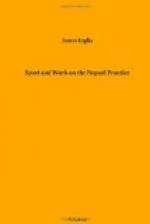This morning we were unlucky with our deer. I shot three, and Captain S. shot at and wounded three, not one of which however did we bag. This part of the country is exclusively inhabited by Parbutteas, the native name for Nepaulese settled in British territory. Over the frontier line, the villages are called Pahareeas, signifying mountaineers or hillmen, from Pahar, a mountain. We beat up to a Parbuttea village, with its conical roofed huts; men and women were engaged in plaiting long coils of rice straw into cable looking ropes. A few split bamboos are fastened into the ground, in a circle, and these ropes are then coiled round, in and out, between the stakes; this makes a huge circular vat-shaped repository, open at both ends; it is then lifted up and put on a platform coated with mud, and protected from rats and vermin by the pillars being placed on smooth, inverted earthen pots. The coils of straw are now plastered outside and in with a mixture of mud, chaff, and cowdung, and allowed to dry; when dried the hut is filled with grain, and securely roofed and thatched. This forms the invariable village granary, and looks at a distance not unlike a stack or rick of corn, round a farm at home. By the abundance of these granaries in a village, one can tell at a glance whether the season has been a good one, and whether the frugal inhabitants of the clustering little hamlet are in pretty comfortable circumstances. If they are under the sway of a grasping and unscrupulous landlord, they not unfrequently bury their grain in clay-lined chambers in the earth, and have always enough for current wants, stored up in the sun-baked clay repositories mentioned in a former chapter.




